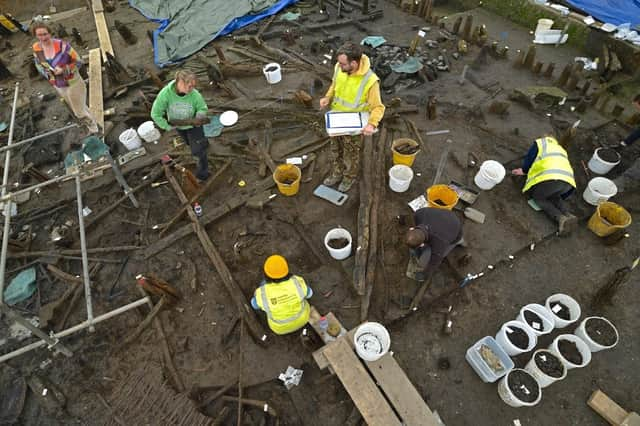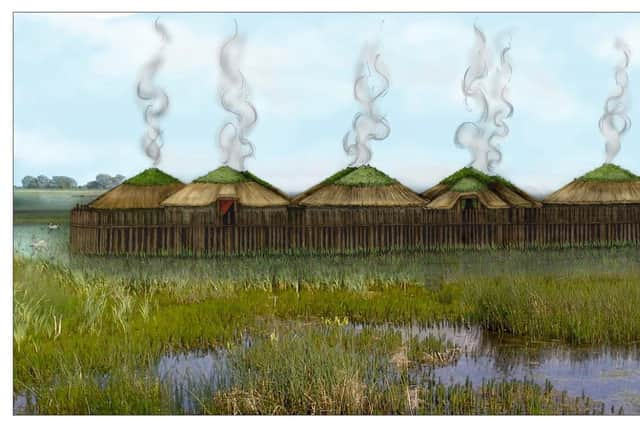New books will reveal remarkable story of Must Farm - dubbed 'Peterborough's Pompeii'


New books published today (Wednesday 20 March) tell the remarkable story of Must Farm – the incredible Bronze Age site found in Whittlesey that shed light on life thousands of years ago.
The discovery of the nationally significant site – dubbed “Peterborough’s Pompeii” - has given an extraordinary insight into everyday life almost 3,000 years ago.
Advertisement
Hide AdAdvertisement
Hide AdNow new books published by the McDonald Institute for Archaeological Research, document the extensive archaeological excavation work, analysis and research that was carried out, and detail the discoveries made.


The two new Open Access publications uncovering the remarkable Must Farm archaeological investigation - "Must Farm pile-dwelling settlement" Volumes 1 and 2 - are the culmination and completion of the Must Farm project supported by Historic England and Forterra.
Discoveries ‘connected us directly with communities from the past’
Duncan Wilson, Historic England Chief Executive, said: “The discoveries made at Must Farm are truly astonishing. They have helped to broaden our understanding of life in the Bronze Age, connecting us directly with communities from the past and helping us to understand a way of life that was more sophisticated than we could have imagined. I’m so proud of this partnership project and look forward to seeing the results and analysis of this amazing excavation laid out in these beautifully produced volumes.”
Dr Tamsin O'Connell, Head of the Department of Archaeology, University of Cambridge, added: “We are delighted to have been involved with the work at Must Farm. The insight it has given us into daily life in the Late Bronze Age is extraordinary. This project on a site of international significance is an outstanding example of the Cambridge Archaeological Unit’s consistently excellent work over more than three decades.”
Advertisement
Hide AdAdvertisement
Hide AdThe Must Farm settlement dates to the end of the Bronze Age (850 BC) and was made from trees taken from local woodland where its inhabitants also hunted wild boar and red deer. It is now known that the site was only occupied for between nine months and a year before a catastrophic fire destroyed it.
The fire spread quickly and as the buildings burned, their flexible floors collapsed, causing their contents to drop into the muddy river beneath, where they were remarkably preserved.
Environmental analysis has shown that the vegetation in the river helped to cushion the material falling from the structures, preventing damage. The items landed directly underneath where they had been stored in the houses, giving archaeologists a direct insight into how the roundhouses were used.
The combination of charring and waterlogging caused thousands of objects to survive, including almost 200 wooden artefacts, over 150 fibre and textile items, 128 pottery vessels and more than 90 pieces of metalwork.
Advertisement
Hide AdAdvertisement
Hide AdThe circular wooden houses are believed to be the best-preserved Bronze Age dwellings ever found in Britain. An astonishing 18,216 pieces of structural wood were recorded. The excellent survival of the settlement’s timber provides archaeologists with an extraordinary degree of insight into the buildings’ architecture.
This time capsule contained rare personal items including decorated textiles – some of the finest produced in Europe at that time - pots and jars complete with meals and utensils, and exotic glass beads – some of which were manufactured in the Middle East - revealing a sophistication not normally associated with the Bronze Age. The footprints of people who once lived in the settlement were also found.
New exhibition planned for Peterborough Museum
Tim Darling, Forterra’s Head of Land and Mineral Resources, said: “The realisation of the Must Farm settlement immediately adjacent to our modern world of mechanisation and advanced technology is absolutely amazing. The juxtaposition of the Cambridge Archaeological Unit and Historic England discoveries positioned only metres from our deep Oxford Clay quarry and the busy A605 road has been incredible to see and a privilege to support.”
A special exhibition will be held at Peterborough Museum next month, giving visitors an opportunity to see some of the preserved and unique objects that have been uncovered by the Cambridge Archaeological Unit. Introducing Must Farm, a Bronze Age Settlement is an insightful, engaging and free to visit exhibition at Peterborough Museum & Art Gallery, supported by Historic England. It will be open to the public from 27 April to 28 September.
Advertisement
Hide AdAdvertisement
Hide AdThe exhibition includes physical objects from the dig, such as a range of pottery, textiles, jewellery and a large illustration of inside one of the roundhouses, to give visitors a sense of what everyday Bronze Age life was like in the Fens.
“We can actually see everyday life during the Bronze Age”
David Gibson, Archaeological Manager, the Cambridge Archaeological Unit, said: “Usually, at a Later Bronze Age period site you get pits, post-holes and maybe one or two really exciting metal finds. Convincing people that such places were once thriving settlements takes some imagination. But this time so much more has been preserved – we can actually see everyday life during the Bronze Age in the round – it’s prehistoric archaeology in 3D with an unsurpassed finds assemblage both in terms of range and quantity. The vast breadth of scientific research within these two books gives unique insight into how people lived in the Bronze Age.”
Dr Matthew Davies, Series Editor, McDonald Monographs, said: “The richness of preservation and exemplary excavation at Must Farm make it the most significant example of daily life in the British Bronze Age and a landmark in modern archaeology. The McDonald Institute for Archaeological Research is honoured to have the opportunity to publish the results of this work and we hope that both specialist and general readers will be enthralled by the combination of detailed scientific analyses alongside stunning visual imagery of the site.”
The two books Volume 1 (general synthesis) is OpenAccess online and is also published in book form from Pen and Sword (priced at £45).
Volume 2 (specialist reports) is OpenAccess and digital only.
For more information visit https://www.pen-and-sword.co.uk/Must-Farm-pile-dwelling-settlement/p/50476